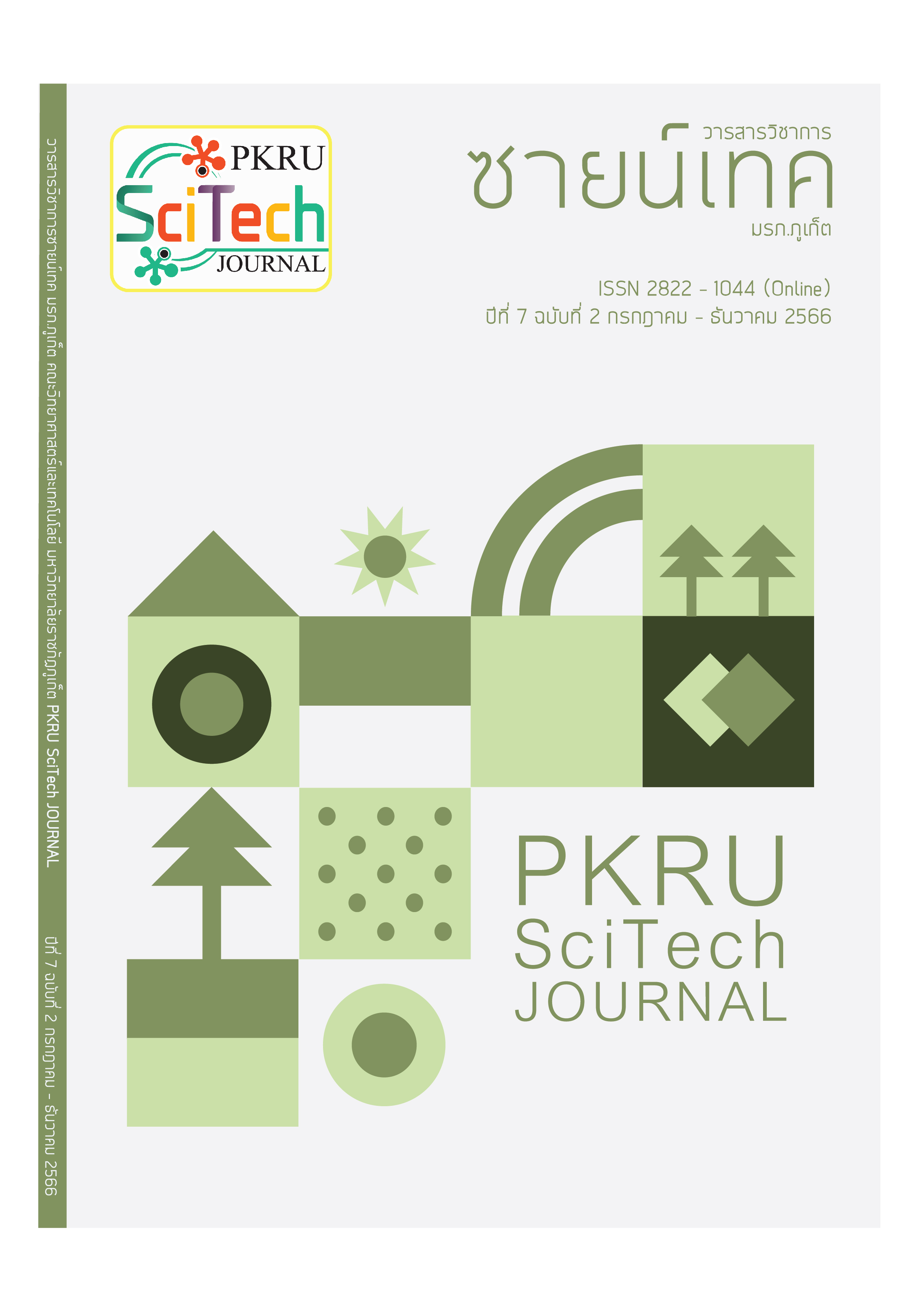การศึกษาอัตราส่วนที่เหมาะสมของแป้งข้าวเจ้า แป้งมันสำปะหลัง และแป้งข้าวโพด ต่อคุณภาพของฝั่นโก๋โดยใช้เทคนิคการออกแบบการทดลองแบบผสม
Main Article Content
บทคัดย่อ
งานวิจัยนี้มีวัตถุประสงค์เพื่อศึกษาปริมาณที่เหมาะสมของแป้งข้าวเจ้า แป้งมันสำปะหลัง และแป้งข้าวโพด ที่มีผลต่อคุณภาพของฝั่นโก๋ โดยใช้การออกแบบการทดลองแบบผสม ผลการวิเคราะห์คุณภาพทางกายภาพ พบว่า เมื่อเพิ่มปริมาณแป้งมันสำปะหลัง ค่าความสว่าง (L*) และค่าสีแดง (a*) มีค่าเพิ่มขึ้น แต่ ∆E มีค่าน้อย ซึ่งใกล้เคียงกับสูตรมาตรฐาน (สูตรที่ 3) ในทางกลับกันค่าสีเหลือง (b*) มีค่าลดลง เมื่อปริมาณแป้งมันสำปะหลังเพิ่มขึ้น ทำให้ค่าแรงตัด (g) และค่าการเปลี่ยนแปลงความหนืดของแป้งมีค่าเพิ่มขึ้น การประเมินคุณภาพทางประสาทสัมผัส พบว่า ผู้บริโภคให้คะแนนเฉลี่ยในคุณลักษณะด้านความใสของแป้ง ความหนืดของแป้ง ความนุ่มของแป้ง และความชอบโดยรวมมีความแตกต่างกัน (p≤0.05) และสูตรที่ผู้บริโภคให้คะแนนสูงในทุกด้าน คือ สูตรทดลอง 6 ซึ่งมีอัตราส่วนของแป้งข้าวเจ้า : แป้งมันสำปะหลัง : แป้งข้าวโพด เท่ากับ 40 : 50 : 10 กรัม ตามลำดับ การยอมรับของผู้บริโภคที่มีต่อฝั่นโก๋ พบว่า ความใสของแป้งสูตรมาตรฐาน (สูตรที่ 3) มีการยอมรับมากกว่าสูตรทดลอง 6 แต่ความนุ่มของแป้งมีการยอมรับสูตรทดลองมากกว่าสูตรมาตรฐาน ส่วนความหนืดของแป้งและความชอบโดยรวมของแป้งทั้ง 2 สูตร มีการยอมรับไม่แตกต่างกัน (p>0.05) ผลการเปรียบเทียบราคาต้นทุนในการผลิต พบว่า ฝั่นโก๋สูตรทดลองมีราคาต้นทุนที่น้อยกว่าฝั่นโก๋สูตรมาตรฐาน
Article Details

อนุญาตภายใต้เงื่อนไข Creative Commons Attribution-NonCommercial-NoDerivatives 4.0 International License.
- เนื้อหาต้นฉบับที่ปรากฏในวารสารเป็นความรับผิดชอบของผู้เขียน ทั้งนี้ไม่รวมความผิดพลาดอันเกิดจากเทคนิคการพิมพ์
- ลิขสิทธิ์ต้นฉบับที่ได้รับการตีพิมพ์ในวารสารวิชาการ ซายน์เทค มรภ.ภูเก็ต ถือเป็นกรรมสิทธิ์ของวารสารวิชาการ ซายน์เทค มรภ.ภูเก็ต
เอกสารอ้างอิง
ศิริลักษณ์ รอตยันต์. (2556). ติ่มซำห้องแถวเป็นอาชีพ (พิมพ์ครั้งที่ 1). กรุงเทพฯ: สำนักพิมพ์แสงแดด.
Sweet Treats @ Sweet Survive. (2558). แป้งสำหรับอาหารชนิดต่าง ๆ. [ออนไลน์], สืบค้นจาก
http://sweetsurvive.blogspot.com/2015/02 (17 พฤศจิกายน 2565).
ชฎาพร จันบํารุง, กมลวรรณ แจ้งชัด, และอนุวัตร แจ้งชัด. (2563). ผลของแป้งข้าวโพด แป้งข้าวเจ้า และสารปรับปรุงเนื้อสัมผัสต่อคุณภาพอาหารว่างชนิดแท่งอบกรอบจากฟักทอง (หน้า 767-774). ใน การประชุมทางวิชาการของมหาวิทยาลัยเกษตรศาสตร์ ครั้งที่ 58. กรุงเทพฯ.
สุวรนี ปานเจริญ, และปิยพัชร จันทร์สุข. (2565). ผลของแป้งมันสำปะหลังต่อคุณสมบัติทางกายภาพเคมี และประสาทสัมผัสของผลิตภัณฑ์ปลาเส้นจากปลาช่อนจังหวัดสิงห์บุรี. วารสารวิทยาศาสตร์และเทคโนโลยี มหาวิทยาลัยราชภัฏเชียงราย, 1(1), 57-65.
Sriroth, K., Piyachomkwan, K., Wanlapatit, S., & Oates, C. G. (2000). Cassava starch technology: The Thai experience. Starch, 52(12), 439-449.
ละออง วรรณศรีจันทร์. (2551). การใช้แป้งข้าวเจ้าทดแทนแป้งสาลีในการผลิตแป้งชุบทอด. วารสาร มทร.อีสาน ฉบับวิทยาศาสตร์และเทคโนโลยี, 1(1), 70-80.
นรินทร์ เจริญพันธ์, และกนกพร ภาคีฉาย. (2562). การศึกษาสูตรที่เหมาะสมในการผลิตถ้วยทาร์ต
ปราศจากกลูเตน. วารสารเทคโนโลยีการอาหาร มหาวิทยาลัยสยาม, 14(1), 26-36.
อรพินท์ อัจฉริยกาญจน์. (2558). 114 เมนูอาหารว่างสไตล์จีน (พิมพ์ครั้งที่ 1). กรุงเทพฯ: กู๊ดเฮด พริ้นท์ติ้ง แอนด์ แพคเกจจิ้ง กรุ๊ป จำกัด.
ณัฐพนธ์ นันทพรพิสุทธิ์. (2563). ติ่มซำเงินล้าน (พิมพ์ครั้งที่ 2). กรุงเทพฯ: สำนักพิมพ์แม่บ้าน.
ปภากร ศรีสอน, พัชนี บุญธกานนท์, อนงค์นาฏ โสภณางกูร, และญาธิปกร ธีระภัทรพลชัย (2563). ผลของการเก็บรักษาแบบแช่แข็งต่อคุณภาพของแป้งขนมช่อม่วงจากแป้งหอมนิลพรีเจลาติไนซ์. วารสารวิทยาศาสตร์และเทคโนโลยี มหาวิทยาลัยอุบลราชธานี, 22(3), 92-102.
อัตรพร นิยมรัมย์, อัมพิการ์ ว่องไวย์, นิตยา ภูงาม, ณัฎวลิณคล เศรษฐปราโมทย์, และวีรเวทย์ อุทโธ. (2564). ผลของแป้งข้าวโพด ข้าวเหนียวก่ำต่อคุณภาพของผลิตภัณฑ์เส้นก๋วยจั๊บอุบล. วารสารนวัตกรรมวิทยาศาสตร์เพื่อการพัฒนาอย่างยั่งยืน, 3(1), 32-45.
Balet, S., Guelpa, A., Fox, G., & Manley, M. (2019). Rapid Visco Analyser (RVA) as a tool for measuring starch-related physiochemical properties in cereals: A review. Food Analytical Methods, 12, 2344-2360.
สุภารัตน์ เรืองมณีไพฑูรย์. (2542). การศึกษาเปรียบเทียบสตาร์ช มันเทศกับสตาร์ชชนิดอื่นในการผลิตบะหมี่กึ่งสำเร็จรูปชนิดทอด. วารสารวิทยาสารเกษตรศาสตร์ สาขาวิทยาศาสตร์, 33(3), 452-460.
Pato, U., Yusuf, Y., Isnaini, R. F., & Dira, D. M. (2016). The quality of instant noodle made from local corn flour and tapioca flour. Journal of Advanced Agricultural Technologies, 3(2), 118-123.
Dupuis, J. H., & Liu, Q. (2019). Potato starch: A review of physicochemical, functional, and nutritional properties. American Journal of Potato Research, 96(2), 127-138.
มะนาว. (2559). แป้งทำอาหาร แต่ละชนิดต่างกันอย่างไร?. [ออนไลน์], สืบค้นจาก https://maanow.com (8 มีนาคม 2566).
Gomand, S. V., Lamberts, L., Derde, L. J., Goesaert, H., Vandeputte, G. E., Goderis, B.,. & Delcour, J. A. (2010). Structural properties and gelatinisation characteristics of potato and cassava starches and mutants thereof. Food hydrocolloids, 24(4), 307-317.
ธัญญาภรณ์ ศิริเลิศ. (2553). การพัฒนาเนื้อสัมผัสของก๋วยเตี๋ยวเส้นเล็กและการลวกสุกไว. วารสารเทคโนโลยีการอาหาร มหาวิทยาลัยสยาม, 5(1), 18-25.
กมลทิพย์ เอกธรรมสุทธิ์. (2557). การปรับปรุงเนื้อสัมผัสของขนมจีนแป้งสดโดยใช้แป้งข้าวโพด. วารสารวิทยาศาสตร์เกษตร, 45(2)(พิเศษ), 665-668.
วิจิตรา เหลียวตระกูล, และวชิรญา เหลียวตระกูล. (2563). ผลของวิธีการโม่ต่อสมบัติทางเคมีกายภาพ ความหนืดและการแยกตัวของน้ำของแป้งกระจับ (Trapa bispinosa). Thai Journal of Science and Technology, 9(2), 251-264.


